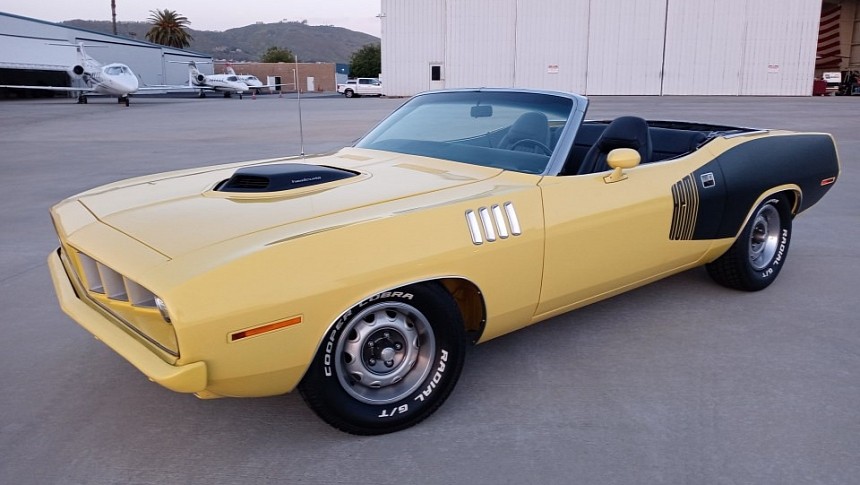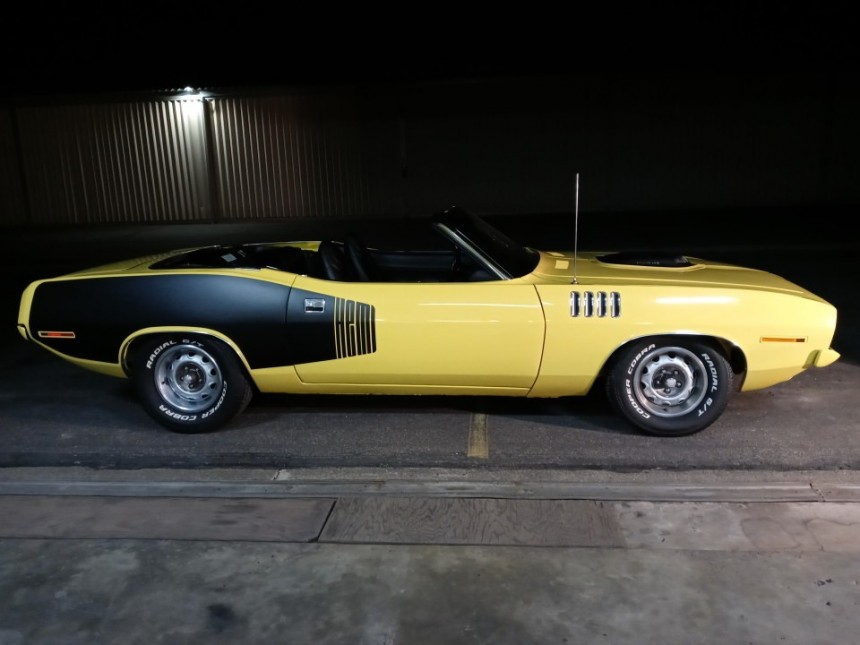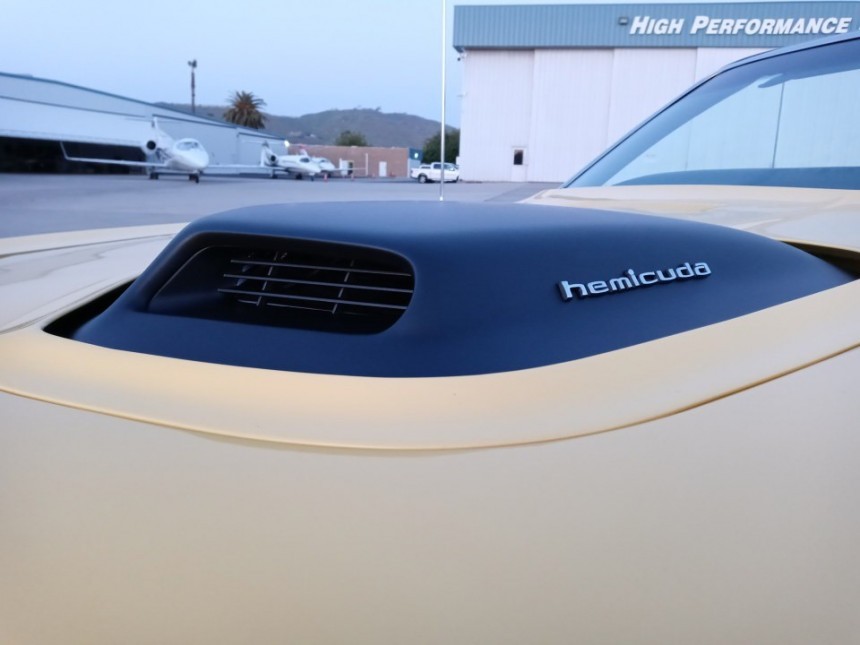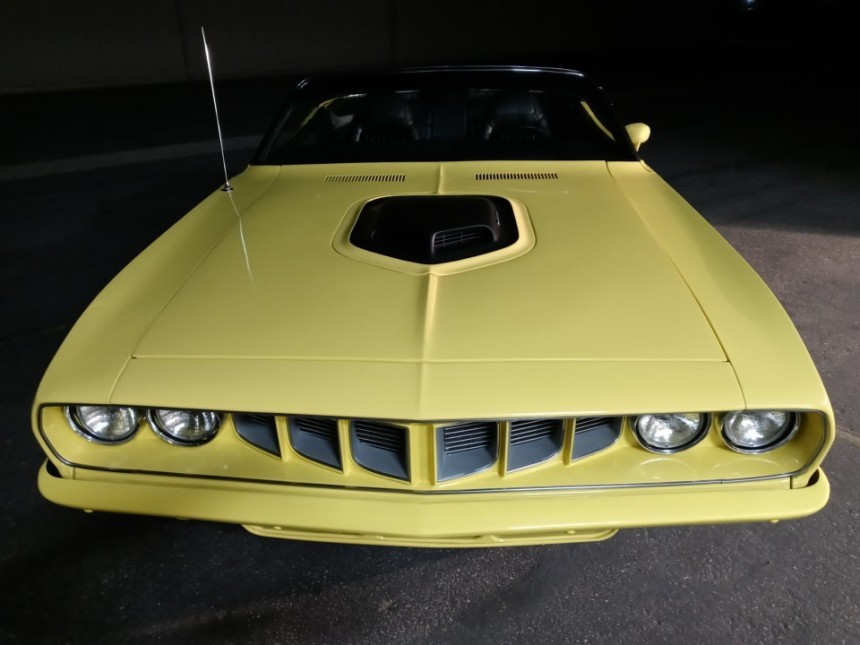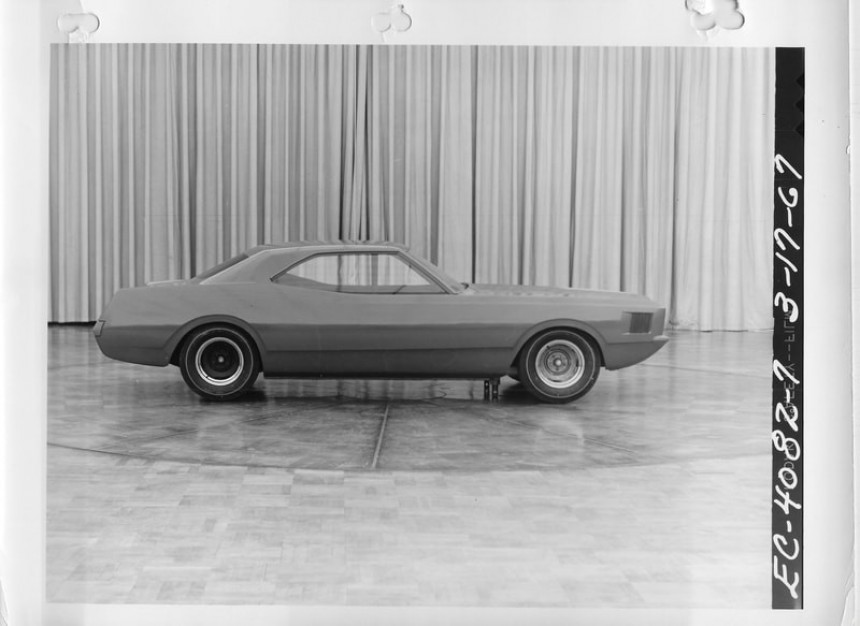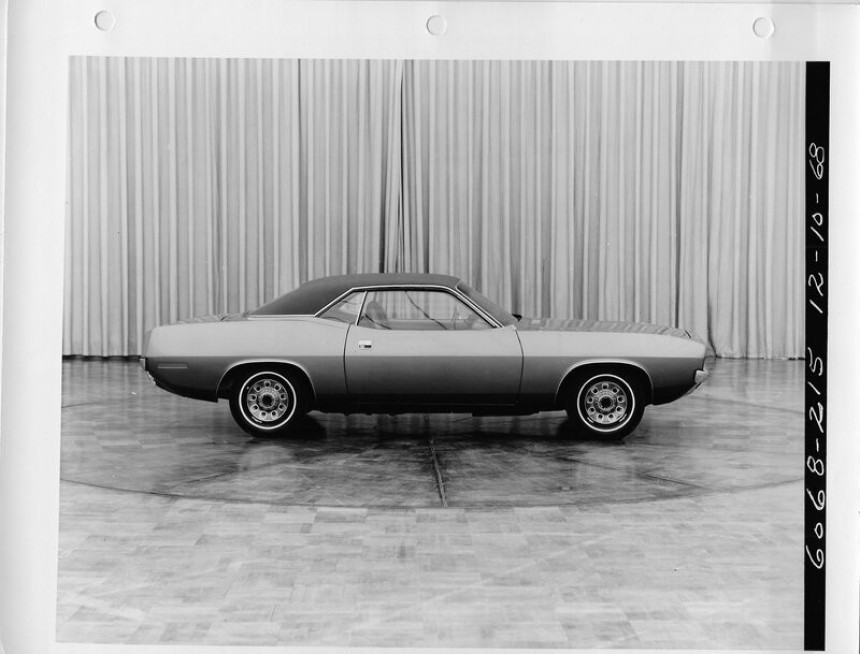The late sixties could easily claim the top spot on the “the greatest times to be alive” contest if the poll were to be conducted solely among a specific group of subjects: muscle car fans. The Charger R/T and Daytona, the Chevy L-88 and ZL-1, the Bosses, the Superbird, the Shelbys, and the GTX are music to wrench turners high and low. The paradisiac age came to a bitter end the next decade, not before gifting the Motor Galaxy with one epochal creation: the convertible hemicuda of 1971.
The spelling in the opening paragraph is intentional. It sticks to the Chrysler scripting used on the air ducts planted in the middle of the hoods of those extra rare gems. As any Mopar tribesman will tell, only seven 1971 ragtops wore Plymouth’s ‘Cuda moniker while conceal-carrying the 426 cubic-inch RB demigod.
Chrysler preferred to axe the HEMI engine altogether after 1971 rather than choke its emissions and desecrate its performance. This decision and the low production of the soft-top ‘Cuda made these automobiles the Holiest Grail in the industry. In the following decades, the ’71 convertible HEMI ‘Cuda rose in value a thousandfold.
Gearheads wished it was a metaphorical exaggeration, but it’s the capitalist reality – the window sticker for a new “Cuda 8 Cyl. 2 Door Convertible” stated a base price of $3,391.00. That’s before the “426 CID 8-Cyl 2-4 BBL Hemi” option was checked (another $883.90). With several more extras, the car could have reached $5,000.
Nowadays, the rare survivors that come up for sale – once in a blue moon – shame hypercar price tags without blinking. The latest sale of a convertible HEMI ‘Cuda (vintage 1971) was a $2.5-million affair, and that was seven years ago. Recently, another one popped up for $2.75 million (but curiously, no bids were made on eBay).
For someone with that much money to spend on a car, the alternative is to have a change of mind and buy some outrageously pompous modern brand that scores above 250 mph (400+ kph). The new owner can then book a trip around the moon with the funds saved from not buying the old Plymouth.
Another thing would be to have a change of heart and go for a built replica; before you keyboard-lapidate me into the BEV afterlife, hear me out. Besides the obvious 426-cube (seven-liter) Mother Of All Barracudas under the shaker scoop, what is the mechanical difference between an original hemicuda and a HEMI-swapped 318 with a heavy-duty four-on-the-floor?
It would take a very trained viewer to point out the inconsistencies after a careful inspection; a motorhead with a knack for genuine muscle might frown. An enthusiast (with enough money to fulfill a high-octane dream) might consider spending $325,000 on a well-built ’71 ‘Cuda Convertible with a 426 HEMI and a manual four-speed.
After all, out of the seven initially sold in the States, just two came with three pedals and four forward speeds. And they’re worth about as much as a private jet, so the previously mentioned price might seem like a bargain.
The ‘Cuda’s ascension to symbol status took off in 1968. Mother Mopar planted big-blocks into small bodies, leaving out creature comforts like power-assisted steering or air conditioning. Chrysler followed up on its initiative and delegated George Hurst to prepare HEMI-powered Dodge Darts and Plymouth Barracudas for NHRA Super Stock racing.
The 50-unit race production ignited the eternal flame of desire for hemispherical heads in street cars (their drag-racing success was a great sales incentive). For the 1970 model year, the first HEMI-powered road-legal Plymouth ‘Cuda rolled out. The design was refreshed from the ground up – the fastback was terminated, and only the convertible and hardtop body styles remained.
Speaking of the body: Chrysler decided to mass-produce the high-performance Barracuda in-house, beginning with the 1970 model. The design was moved from the small pony-car A-body to the E-body chassis, seeing the restyled ‘Cuda share its underpinnings with the then-newly launched Dodge Challenger.
Two versions of the Barracuda re-design story are told by two people directly involved in the development. According to the first one (by former Chrysler designer John Samsen), when Plymouth designers were developing the 1970 model, Elwood Engel – Chrysler’s head stylist – dropped by the studio on a late Friday afternoon.
The fender line of the full-size clay model wasn’t to his liking, so he took a hammer and started “correcting” the angles and profile. The following Saturday, he called in the Barracuda design team and directed the upgrades of the clay model. Eventually, Plymouth’s proposal was chosen over Dodge’s alternative, so the Challenger had to accept a facelifted variant of the ‘Cuda profile.
The more succulent recall of the events is John Herlitz’s version, as he was primarily seen as the driving force behind the third generation ‘Cuda looks. As he recalled in an interview, Engel (notorious for walking through the design studios on weekends to view the progress of projects) didn’t like the initial concept of the ’70 Barracuda.
“I came in on a Monday morning, and there’s a hatchet in the side of the car, the clay model. And that was not a good sign,” Herlitz described. Eventually, the emblematic automobile came into metal, and Engel was among the first ones to take it for a spin.
He took “one of the early prototype cars off the elevator on the third floor of Building 128. And it was a HEMI. A green HEMI ’Cuda. And he got it angled around into the hallway that led down to the design auditorium, and he nailed that car on this parquet floor and just left these two black tracks down the hallway.”
Located in San Diego, one Lemon-Twist-Yellow-over-Black HEMI 'Cuda convertible is ready to repeat that parallel mark act. According to its current owner, the car is a rotisserie restoration of a 1971 318-factory-equipped . A period-correct 426 HEMI V8 and ancillaries now sit under the shaker hood, and an A833 manual transmission (18-spline heavy-duty) puts the 425 hp and 490 lb-ft (431 PS/664 Nm) on the ground.
The 3.23 rear would make this built-not-bought ‘vert HEMI ‘Cuda a highway-friendly ride, and the front disc brakes and vented rear drums (both factory equipment) are claimed to be solid and reliable. The respawned Plymouth now sports the 'HEMI' script on the rear quarters.
The staple blowholes in the hood also leave no room for error - this is a real-deal muscle machine. The car is offered for sale, and the price of $325,000 can be covered in cash, bank transfer, and crypto (Bitcoin), with trades considered.
Chrysler preferred to axe the HEMI engine altogether after 1971 rather than choke its emissions and desecrate its performance. This decision and the low production of the soft-top ‘Cuda made these automobiles the Holiest Grail in the industry. In the following decades, the ’71 convertible HEMI ‘Cuda rose in value a thousandfold.
Gearheads wished it was a metaphorical exaggeration, but it’s the capitalist reality – the window sticker for a new “Cuda 8 Cyl. 2 Door Convertible” stated a base price of $3,391.00. That’s before the “426 CID 8-Cyl 2-4 BBL Hemi” option was checked (another $883.90). With several more extras, the car could have reached $5,000.
For someone with that much money to spend on a car, the alternative is to have a change of mind and buy some outrageously pompous modern brand that scores above 250 mph (400+ kph). The new owner can then book a trip around the moon with the funds saved from not buying the old Plymouth.
Another thing would be to have a change of heart and go for a built replica; before you keyboard-lapidate me into the BEV afterlife, hear me out. Besides the obvious 426-cube (seven-liter) Mother Of All Barracudas under the shaker scoop, what is the mechanical difference between an original hemicuda and a HEMI-swapped 318 with a heavy-duty four-on-the-floor?
After all, out of the seven initially sold in the States, just two came with three pedals and four forward speeds. And they’re worth about as much as a private jet, so the previously mentioned price might seem like a bargain.
The ‘Cuda’s ascension to symbol status took off in 1968. Mother Mopar planted big-blocks into small bodies, leaving out creature comforts like power-assisted steering or air conditioning. Chrysler followed up on its initiative and delegated George Hurst to prepare HEMI-powered Dodge Darts and Plymouth Barracudas for NHRA Super Stock racing.
Speaking of the body: Chrysler decided to mass-produce the high-performance Barracuda in-house, beginning with the 1970 model. The design was moved from the small pony-car A-body to the E-body chassis, seeing the restyled ‘Cuda share its underpinnings with the then-newly launched Dodge Challenger.
Two versions of the Barracuda re-design story are told by two people directly involved in the development. According to the first one (by former Chrysler designer John Samsen), when Plymouth designers were developing the 1970 model, Elwood Engel – Chrysler’s head stylist – dropped by the studio on a late Friday afternoon.
The more succulent recall of the events is John Herlitz’s version, as he was primarily seen as the driving force behind the third generation ‘Cuda looks. As he recalled in an interview, Engel (notorious for walking through the design studios on weekends to view the progress of projects) didn’t like the initial concept of the ’70 Barracuda.
“I came in on a Monday morning, and there’s a hatchet in the side of the car, the clay model. And that was not a good sign,” Herlitz described. Eventually, the emblematic automobile came into metal, and Engel was among the first ones to take it for a spin.
Located in San Diego, one Lemon-Twist-Yellow-over-Black HEMI 'Cuda convertible is ready to repeat that parallel mark act. According to its current owner, the car is a rotisserie restoration of a 1971 318-factory-equipped . A period-correct 426 HEMI V8 and ancillaries now sit under the shaker hood, and an A833 manual transmission (18-spline heavy-duty) puts the 425 hp and 490 lb-ft (431 PS/664 Nm) on the ground.
The 3.23 rear would make this built-not-bought ‘vert HEMI ‘Cuda a highway-friendly ride, and the front disc brakes and vented rear drums (both factory equipment) are claimed to be solid and reliable. The respawned Plymouth now sports the 'HEMI' script on the rear quarters.
The staple blowholes in the hood also leave no room for error - this is a real-deal muscle machine. The car is offered for sale, and the price of $325,000 can be covered in cash, bank transfer, and crypto (Bitcoin), with trades considered.
